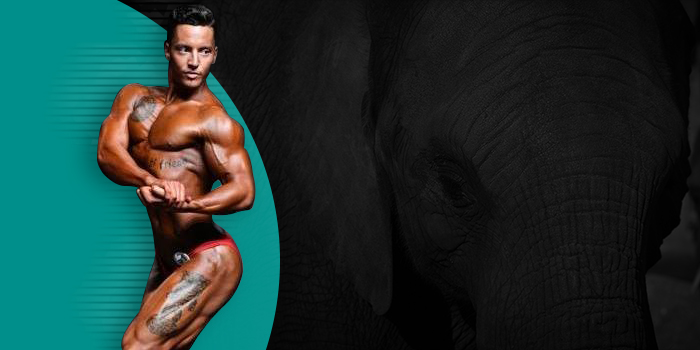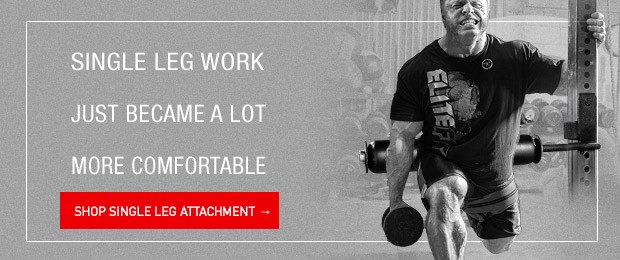
In the interest of chasing a complete physique and achieving total muscular development, I’m a big fan of any movement or piece of equipment that allows you to zero in on a specific muscle with little support from surrounding musculature for unadulterated tissue stimulation.
Enter the much maligned, often ridiculed Smith machine.
From what I’ve experienced with myself and with clients, the core benefit of using the Smith for movements such as a guillotine press or squats is that it typically allows you to place greater emphasis on a specific muscle than its barbell counterpart, with a drastically reduced risk of injury.
RECENT: Tissue Takes Time — 3 Lessons From Improvement Season
In my meathead eyes, anything that can be done to stimulate muscle tissue growth, increase joint longevity, and minimize injury potential should be taken full advantage of. I’m not saying that you should abandon all the bread-and-butter barbell movements that strike fear into your soul in place of the relatively safe space that is the Smith machine. You still need to do the classic hard stuff.
What I am saying that you should integrate (without replacement) movements using the Smith machine for your sessions with the intention of creating a new stimulus, taking advantage of its ability to let you push past a normal threshold of failure and creating obscene amounts of muscle damage in the process. Onward, to what I’ve discovered to be the best uses for doing just so with the ridiculed Smith Machine.
Back Squats
Back squats on the Smith are fantastic for two reasons:
- If you have easily-aggravated lower back issues that cry out when you push too hard with the barbell, often said issues can be rectified by swapping over to the Smith and using a shoulder width stance with your feet walked out in front of you. Problem solved.
- It’s much easier to manipulate your stance to target different musculature in your legs. Narrow while coming up on the balls of your feet, wide with toes pointed out, shoulder width out in front of you...the list goes on. Depending on your goal of the session, you can roast your glutes and hamstrings, quads, or zero in on your teardrop, all with a few simple foot placements.
Front Squats
My main beef with barbell front squats is that in most cases it isn’t your legs that are the limiting factor – it’s your upper back, which is all but guaranteed to tire before your legs. When I program for hypertrophy, the intention of most exercises within a given session is to have the target muscle be the limiting factor, not accessory or supporting muscles.
In the case of barbell front squats, your upper back and rhomboids will start to falter somewhere in the seven to nine rep range, well before your legs tire or are effectively stimulated. Jump over to the Smith machine, though, and you can load up your legs while removing much of the support from your upper back. Hello, hello, sets of high rep front squat from hell.
Lunges
Behold the muscle-building trident of why I love programming lunges in the Smith machine:
- Between facility size and layout of the equipment, some gyms are simply not well-suited for lengthy sets of walking lunges.
- Having the load placed across your back yields a slightly different stimulus than holding dumbbells by your side.
- You can have a lot of “fun” with tempo manipulation.
Simple as that.
Guillotine Press
In all honesty, I will choose Smith machine guillotine presses over their barbell counterpart nine times out of 10, purely for safety reasons.
With the massive stretch guillotine presses dole upon your chest, and how they can compromise your shoulder integrity, I much prefer to have guillotine presses executed within a fixed range of motion, rather than using a barbell of which you may or may not lose control at any given moment. These reasons are especially relevant since guillotine presses are better suited to be done later in a session, with fully pumped (and fatigued) pecs.
Seated Military Press
I’ve come across few lifters or clients who don’t have some sort of shoulder injury in their history. For many, this can cause some sticky problems when it comes to overhead pressing. Doing so in the Smith allows you to once again take advantage of a fixed range of motion and focus on overloading your shoulders while also working on a proper bar path.
More often than not, the irritation from barbell military pressing is removed when the exercise is taken to the Smith.
“Barbell” Rows
Full credit for Smith machine rows must go to the Mountain Dog himself, John Meadows. I stumbled upon John’s use of smith machine rows in his old T-Nation articles from years back, and they forever changed my back training. In my experience, being able to remove the stress placed on your lower back, and isolate nothing but your lats, is a godsend for training back.
Again, the fixed bar path allows you to focus on what really matters when it comes to effective back training:
- Driving with your elbows
- Moving through a full range of motion
Both of these aspects of effective back training are often overlooked by less experienced trainees.
Skull Crushers
Inspired by Julian Smith, these are a relatively new addition to my arm-training arsenal — and they haven’t disappointed.
Here’s what I’ve found through a little self-experimentation:
- There’s less stress placed on your elbows and shoulders.
- You have increased muscular control, allowing you lengthier sets with more weight than usual.
- There is increased stress placed on your triceps (I mean, that is the whole point).
- You have a greater ability to play with tempo, introduce deadstops, and lower to different points (chin, forehead, behind your head) with small adjustments to your elbow position.
The Final Reps
An idea that popped into my head while I wrote this, and something I’m going to start implementing, is thus:
Any time there’s a movement in my program that I could do on the Smith machine (namely the above), I’m going to do two to three feeler sets on the Smith, then move into the prescribed sets for the barbell counterpart.
My line of thinking is that doing so will serve as a highly targeted warm-up, eliminate any injury risk, and help me get into the groove of an exercise without having to deal with that first couple of awkward feeling sets that often comes with barbell work.
To throw a ribbon on all this and tie it off, I truly believe that the Smith machine, which often gets a bad rap, has many applications and benefits when it comes to building muscle. That being said, I will agree it’s not the end all, be all (but what piece of equipment or movement is, really?).
In effect, the Smith machine is a tool that you should be using within your training, and the above exercises are a great place to start.









